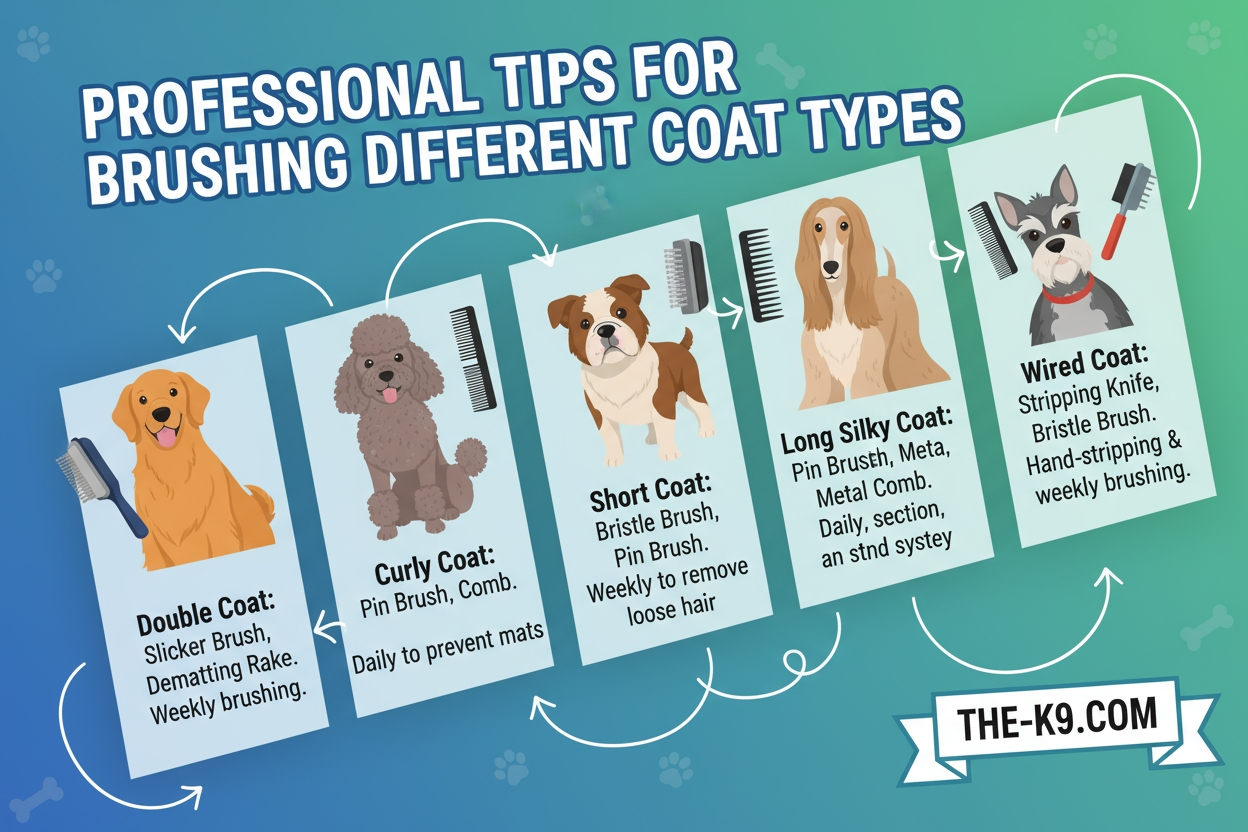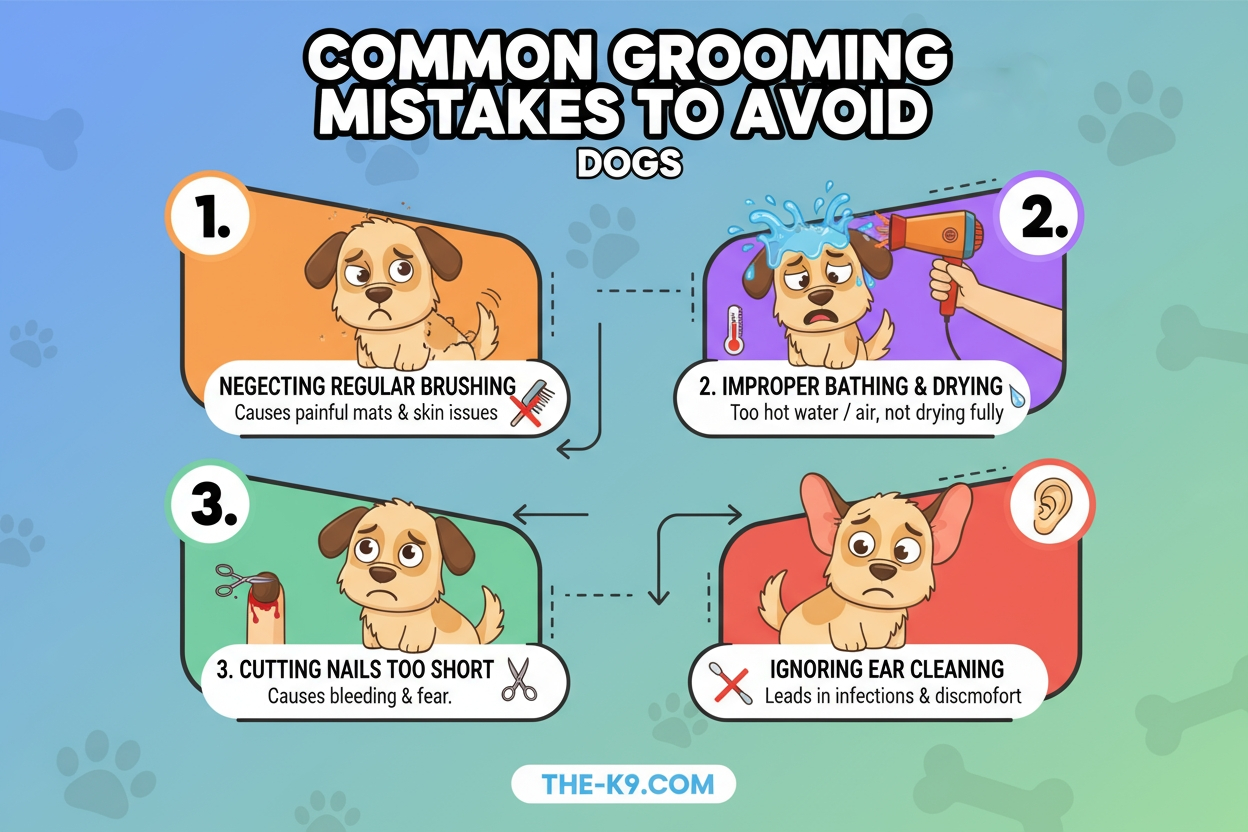Home » Dog Grooming at Home: Essential Tips for Pet Care


Dog Grooming at Home Tips: Brush Regularly (Even Short-Haired Dogs) Regular brushing removes loose fur, prevents mats, and distributes natural oils for a shiny coat. Aim for 2–3 times a week or more for long-haired breeds. Use the Right Tools: Match your tools to your dog’s coat type: slicker brushes for long hair, bristle brushes for short coats, and DE shedding tools if your dog sheds heavily. Make Grooming a Positive Experience:
Use treats, praise, and a calm voice. Start with short sessions and gradually increase the time so your pup associates grooming with good vibes.
Regular grooming at home saves money and strengthens your bond with your dog. With the right tools and techniques, you can cut down on vet bills. This way, you and your dog can enjoy quality time together.
Every dog is different, needing specific grooming based on their breed, coat, and lifestyle. From brushing and baths to nail care and dental health, knowing these needs is vital. It helps prevent health problems and keeps your dog happy and healthy.

Dog grooming at home is more than just keeping your furry friend looking clean. It’s a key part of pet care that affects your dog’s health and happiness. Regular grooming offers many benefits that go beyond just looks.
Following dog grooming safety tips can prevent health problems. Here are the main benefits of regular grooming:
Grooming sessions are great for strengthening your bond with your pet. These interactions help your dog become more comfortable with being handled. They can also reduce anxiety during vet visits.
| Grooming Focus | Health Monitoring Benefit |
|---|---|
| Skin Inspection | Detect early signs of infections or abnormal growths |
| Nail Trimming | Prevent joint problems and mobility issues |
| Ear Checking | Identify potential ear infections |
| Teeth Examination | Spot dental problems early |
By adding regular dog grooming at home to your pet care routine, you’re doing more than just keeping them looking good. You’re also helping their health and happiness.

For successful dog grooming at home, you need the right tools and supplies. Professional groomers and vets say a full toolkit is key to your dog’s health and looks. Knowing which tools are best for your dog’s coat type is crucial.
Here are the must-have dog grooming tools:
When picking grooming tools for home, think about your dog’s breed and coat. Good, durable tools make grooming easier and more fun for you and your dog.
Pro tip: Regular grooming keeps your dog looking good and healthy. It also helps prevent skin problems, catches health issues early, and strengthens your bond with your dog.
Dog grooming at home can be rewarding. It strengthens your bond with your furry friend. With the right tools and approach, you can keep your dog healthy and happy.
Start by understanding your dog’s needs and creating a comfy space. Most dogs can learn to enjoy grooming with patience and training.
| Grooming Task | Recommended Frequency |
|---|---|
| Brushing | 1-2 times per week |
| Nail Trimming | Every 3-4 weeks |
| Ear Cleaning | Once a month |
| Bathing | Every 4-6 weeks (breed dependent) |
Start grooming when your dog is calm. Introduce tools gradually, letting them sniff and get used to them. Use treats and praise to make grooming positive.
About 50% of pet owners brush their pets regularly. This helps a lot with pet health and hygiene. By grooming at home, you keep your dog looking good and catch health problems early.

Dog grooming at home is all about knowing what each coat type needs. Every breed has its own special grooming needs. This is to keep their coat healthy and looking good.
Choosing the right brush is key to avoid skin problems and keep the coat shiny. Short-coated dogs like Beagles and Boxers do well with a weekly brushing. This helps remove loose hair and spreads natural oils.
Professional groomers suggest using specific tools for each coat type. This makes dog grooming at home more effective:
| Coat Type | Recommended Brush | Brushing Frequency |
|---|---|---|
| Short Coat | Rubber-bristled brush | Weekly |
| Double Coat | Undercoat rake | 2-3 times per week |
| Curly Coat | Slicker brush | 3-4 times per week |
| Long Coat | Steel comb | Daily |
Regular grooming does more than just keep your dog looking good. It’s also a chance to check for any health issues. Spend time learning how to brush your dog right. This will keep them healthy and happy.
Dog bathing can be tough for pets and owners. Knowing good dog bathing techniques makes grooming easier and less stressful. About 50% of dog owners find baths stressful, so getting ready is key.
Getting ready for bath time needs careful planning and the right steps. Before you start, collect all needed items and make a calm space for your dog.
When using homemade dog shampoo, make sure it’s safe for pets. Dilute the shampoo right and wash gently with circular motions. Rinse well to avoid skin irritation – leftover soap can itch and hurt.
Pro tip: Stick to a regular bathing schedule to make your dog more comfortable with it.
Dog nail trimming is key for your pet’s health and comfort. It stops problems like splayed feet and painful walking. Regular care is essential.
Knowing your dog’s nail anatomy is vital. The quick is the living part that supplies blood. Cutting it can hurt and bleed.
Choosing the right tools is important for safe grooming:
| Tool Type | Pros | Considerations |
|---|---|---|
| Scissor Clippers | Easy to control | Best for small to medium dogs |
| Guillotine Clippers | Quick cutting | Higher risk of quick damage |
| Nail Grinders | Smooth edges | Noise might frighten some dogs |
Preparation is crucial. Have styptic powder ready for bleeding. Use treats to make the process calm and positive.
Dogs on concrete may naturally trim their nails. Watch your dog’s needs and activity level for the best care routine.
Keeping your dog’s teeth clean is key to dog grooming at home. About 84% of dogs get periodontal disease by age three. So, it’s important to take care of their teeth early on.
Dental care is more than just fresh breath. It’s vital for your dog’s health. It can even prevent serious diseases that affect their life quality.
Teeth brushing needs patience. Begin by letting your dog get used to the toothbrush and toothpaste. Here’s how to do it right:
Pick dental products wisely for your dog grooming routine. Look for ones that vets recommend. They should help fight plaque and tartar.
Good dental care can stop big health problems. Keep an eye out for these signs:
Don’t forget to take your dog to the vet for dental checks. Also, use dental chews to keep their teeth clean.
Dog ear cleaning is key to keeping your pet healthy. It prevents infections and keeps your dog feeling good. It’s important to know how a dog’s ear works to clean it right.
A dog’s ear is shaped like an L with a 90-degree bend. This makes cleaning tricky. You need to be gentle to avoid hurting your dog’s ears.
| Breed Type | Cleaning Frequency | Special Considerations |
|---|---|---|
| Long-Eared Breeds | Every 1-2 weeks | Higher infection risk |
| Short-Eared Breeds | Every 2-4 weeks | Less prone to infections |
Use a soft ear cleaner and cotton balls for cleaning. Gently massage the ear base for 30 seconds. Look out for signs of infection like too much wax or a bad smell.
Give your dog a treat after cleaning to make them happy. This makes ear care easier for both of you.
Dog grooming at home needs a deep understanding of various breed types. Each dog’s coat has its own challenges and care needs. Pet owners must address these during grooming sessions.
Different coats need special care to stay healthy and look good. Knowing your dog’s grooming needs helps avoid skin problems and keeps their coat shiny.
Short-haired breeds need less grooming but still require regular care. Important steps include:
Long-haired dogs need more detailed grooming at home. Daily brushing is key to prevent matting and tangling. Techniques to use include:
Double-coated breeds require special grooming. Owners should:
Every breed has its own grooming routine. It’s crucial to research and tailor grooming to your dog’s specific needs.

Dog grooming at home needs careful attention and knowledge. Many pet owners make mistakes that can harm their dog’s health and comfort. It’s important to know these common pitfalls to keep your pet well.
Some common dog grooming safety tips include avoiding these mistakes:
Dog grooming at home requires knowing your pet’s unique coat and health needs. Different breeds need different approaches. For example, double-coated dogs like huskies should never be shaved. Their coat protects them from heat and cold.
Choosing the right tools is key. A slicker brush is best for long or curly coats, while bristle brushes suit shorter coats. Always pick tools that match your dog’s grooming needs to avoid discomfort and skin issues.
Getting professional advice can help avoid grooming mistakes. Consider occasional visits to veterinarians or professional groomers. This ensures you’re using the right techniques for your dog.
Dog grooming at home needs to change with the seasons. Spring brings a lot of shedding, with 60% of dog owners noticing more hair. Regular brushing helps cut down indoor hair by 30% and stops mats that can irritate the skin.
Summer is all about keeping your dog cool. Dogs spend more time outside, so they need more baths with moisturizing shampoo. Trimming thick coats is key to avoid overheating, but don’t shave them too much to prevent sunburn. Also, use paw balm to stop burns from hot pavement.
Fall and winter have their own grooming needs. Brushing your dog weekly helps with shedding and skin problems. In winter, bathe them less to keep their coat oils in. Protect their paws from ice, salt, and snow. Using paw balm after walks can help prevent cracks and irritation, with 80% of pet owners seeing better results.
Keeping up with grooming all year is important for your dog’s health and happiness. Services like The Dog House Pet Salon can give you breed-specific advice. This ensures your dog stays clean, comfortable, and healthy all year round.